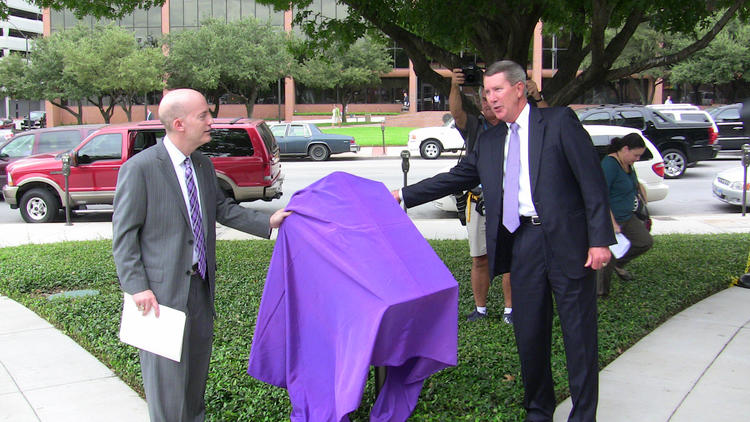The success of the university’s athletics programs was an invaluable asset to the city of Fort Worth, a city official said Monday at a ceremony dedicating a historical marker that recognized the university and city’s 100-year partnership.
Bill Thornton, president and CEO of the Fort Worth Chamber of Commerce, opened a ceremony that unveiled a Heritage Trails historical marker at the corner of Commerce and Weatherford streets that celebrated the university’s century of partnership with Fort Worth.
“The profile and the awareness that goes hand-in-hand with having a prominent athletic department and sports teams8212;it’s hard to put a dollar value on what that means to a community,” Thornton said. “We love that the Frogs have had the kind of success that they have had on the gridiron and on the baseball field.”
He said that university’s athletics in the past year helped the community rally together and it was ironic that the ceremony came ahead of the football team’s season opener this weekend.
Chancellor Victor Boschini said that Fort Worth’s generosity allowed the university to grow and evolve into a world-class, values-centered institution.
Douglas Harman, a Heritage Trails task force member and guiding force behind the Heritage Trails historical markers idea, said he issued a “vision” letter in April 1990 outlining his idea for downtown Fort Worth. His vision was to have a focused tour of downtown around the Heritage Trails historical markers.
With 23 markers positioned at various spots in downtown, Harman said he believed that the markers gave life to the history of Fort Worth. The markers, which began to be put up in 2002, had the flexibility to discuss the history, people, places and events of Fort Worth by using themes, he said.
Harman said that the markers could show a link to listen to speeches concerning the marker’s topic on a media outlet, such as an MP3 player or an iPod. He said the prospect of using social media in conjunction with the markers was exciting.
To commemorate the 100th year of the partnership with the city of Fort Worth, the university decided to sponsor a new Heritage Trails marker that detailed the past of the city and the school.
According to the inscription on the marker, Fort Worth’s Hell’s Half Acre was too “rowdy” a location for a Christian school. The university’s original school building was located near the famous bar district.
The university began its journey of relocation to Thorp Spring and Waco before the Fort Worth Board of Trade, now the Fort Worth Chamber of Commerce, teamed with a landowner and Christian churches to bring the university back to the city in 1910 after fire destroyed the Waco campus.
The university leased space from 1910-1911 at Ingram Flats, a series of two-story brick buildings at Weatherford and Commerce Streets, according to the marker’s inscription.
Heritage Trails, funded by local businesses and foundations, has new markers being unveiled in the coming months, such as Women in Early Fort Worth and Horseless Carriages.

